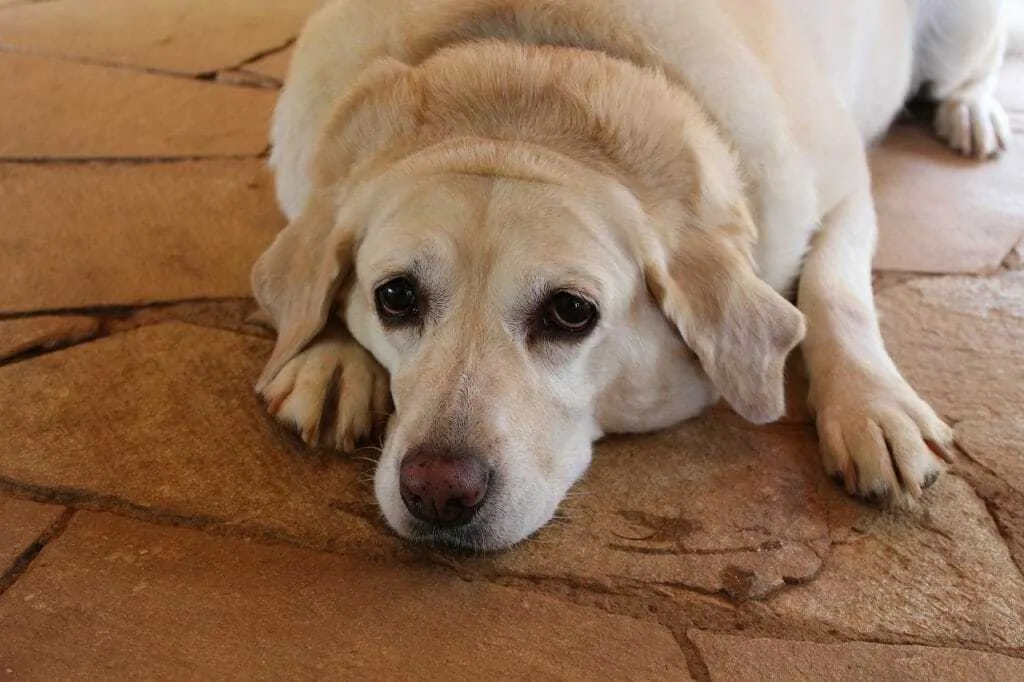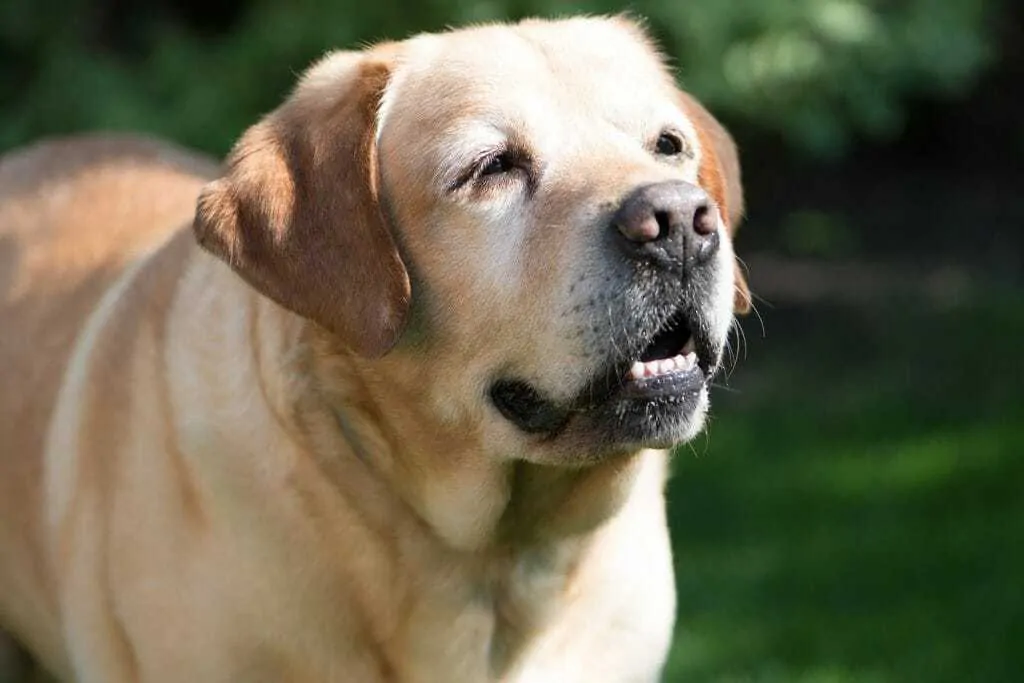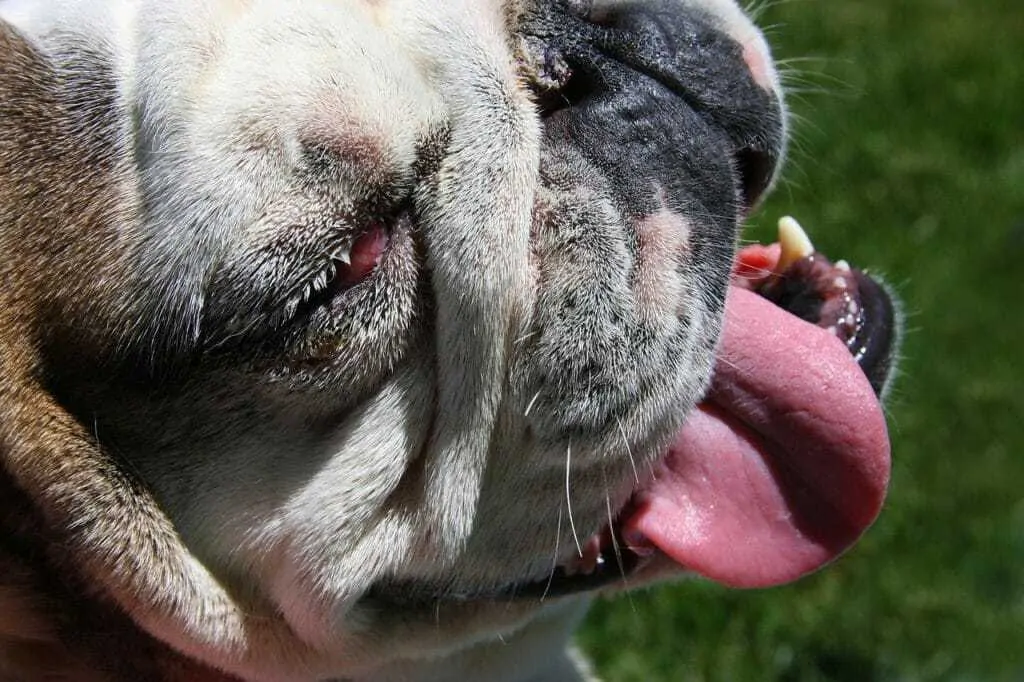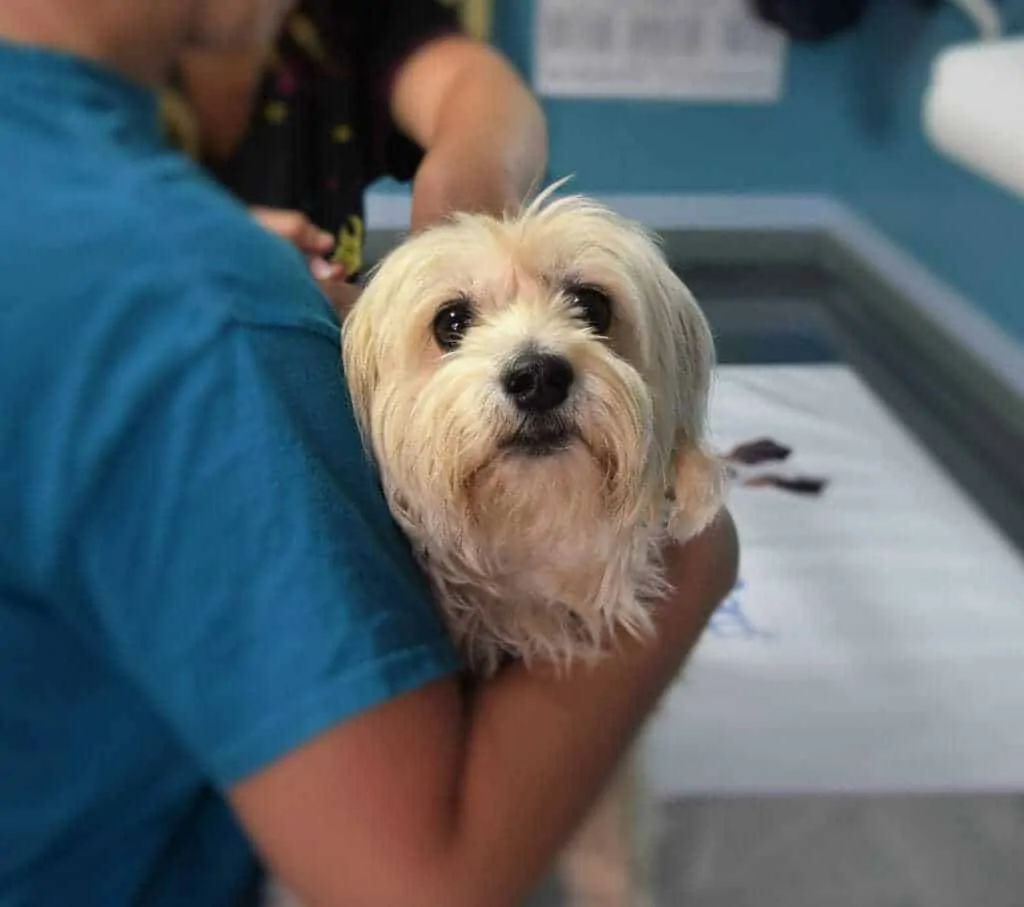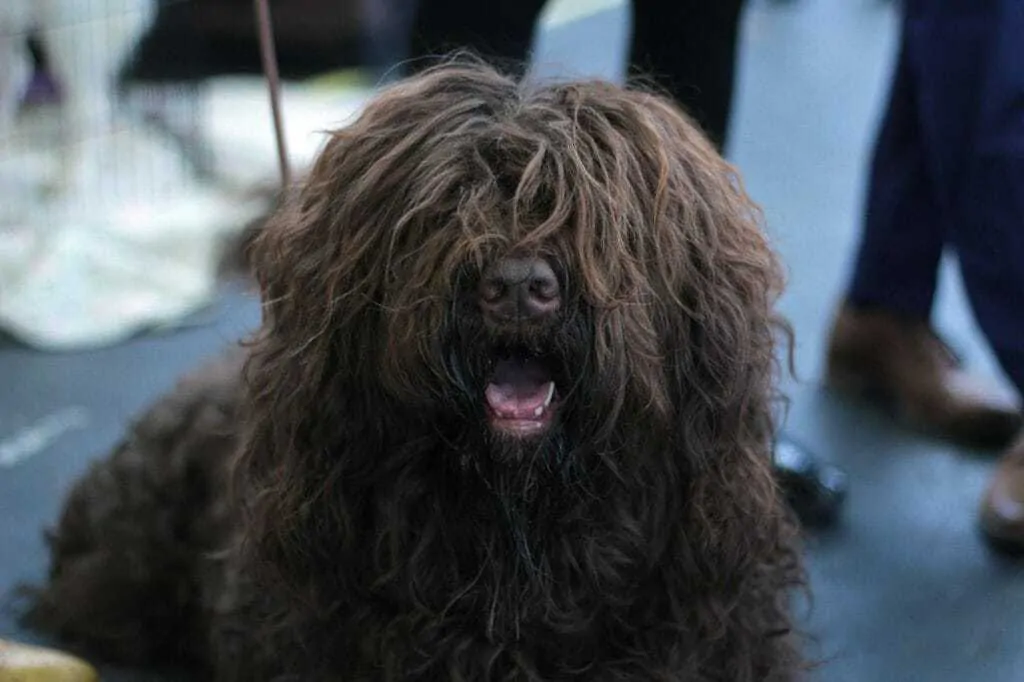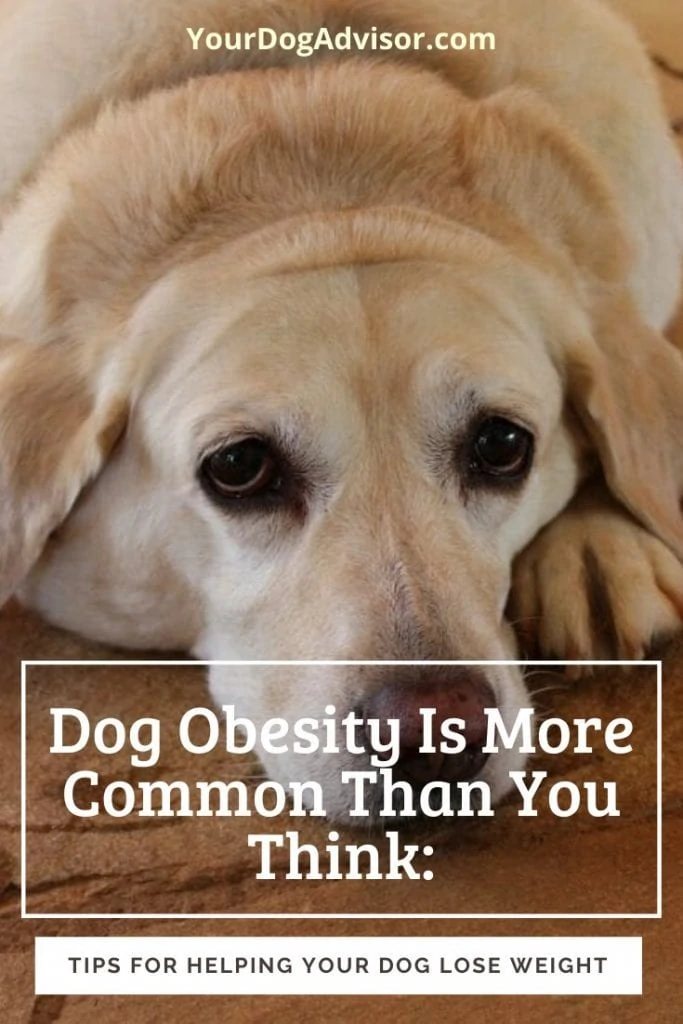What is the most common killer of dogs? Would you be surprised to know that it is obesity-related problems?
Contents
The Statistics Are Concerning
Just look at the statistics and there can be no denying this worldwide trend. The Association for Pet Obesity Prevention (APOP) reports that, in 2017, an estimated 56% of dogs in North America are obese. This is a truly shocking statistic and it tells us that there needs to be a major overhaul in the mindset of us pet owners.
A survey conducted by APOP also showed that, unbelievably, 95% of obese dog owners actually thought that their dog’s weight was within an acceptable range. Some may be in denial but the vast majority are likely actually ignorant of what an acceptable weight should be.
Dog-obesity related problems are the number one killer of our pet dogs
What Can Cause Obesity in Dogs?
There are a whole host of issues that can cause obesity and it can be complex to unravel them. Whilst there are medical conditions and other factors that can influence your dog’s weight, worryingly, the most common problems stem from problems that human owners create for their dogs. The good news though is that this does mean that, if we are aware of these issues, we can actually do something to change things.
1. Over Feeding/ Free-Feeding
Our lack of ability to appropriately portion control and feed the right diet play a huge part. There are so many dog foods on the market now and it can be difficult to understand what food may be the best, most healthy option.
Sometimes is just a lack of understanding or, even a lack of effort, to check what the actual feeding amounts should be. Whilst every dog is different and feeding guides are exactly that, just a guide, it is a good starting point to work from.
It is extremely important to pick a high-quality diet and maintain proper portion control. Food should be weighed out and monitored, treats should generally not make up more than 10% of your dogs diet.
If you are using food for training, consider using their food as part of their rewards, make sure the treats are healthy and low fat and cut them into very small pieces, a little can go a long way.
Another bad habit is when people free-feed their dogs. They want them to be able to eat whenever they are hungry. By always leaving food out for your dog and constantly topping up the bowl this is a sure fire recipe for having an overweight dog.
2. Lack of Exercise
Another statistic that I found extremely sad and very surprising, is that a large percentage of dogs do not even receive one walk a day.
Not only will this lack of appropriate exercise undoubtedly contribute to a dog putting on weight more readily but it just seems downright cruel to deprive your dog of the stimulation and health benefits that come with regular exercise.
Making time to have at least one decent walk is crucially important to your dog and, ideally, they should have more than one walk and also their day should be filled with other activities that can help to keep them active and entertained.
The statistics around the number of dogs that don’t receive at least a daily walk are shocking
3. Human Psychology
Our perception of what is an appropriate weight has changed. When every day you see dogs that are fat, it then morphs into this becoming the acceptable norm and people think that their dog is a good weight when actually they are overweight.
I am very conscious of my dog’s weights and always have been. Cocker Spaniels are a notoriously greedy breed and it can be easy for them to become overweight if owners treat them too much. I, surprisingly regularly, had people comment that they thought my Cocker Spaniels were ‘too skinny’, when in actual fact I knew and had also had confirmation from my vet, that they were a healthy weight.
Sometimes it is just that old expression of ‘killing them with kindness’. We see them begging cutely for some yummy table scraps and we can’t help but cave in. We see spoiling them with food like this as a way to shower them with love when, in actual fact, we could be doing them a disservice.
4. Breed Predispositions
There are some breeds that are more likely to gain weight more easily than others.
There are also breeds that have a notorious reputation for being super greedy. Breeds like Cocker Spaniels and Labradors.
Whilst it is recognised that there are breeds that are prone to put on the pounds more readily, this does not mean that this should be used as an excuse. Owners of these types of breeds should just be more vigilant about their dog’s diet and exercise regime to help them maintain a healthy weight.
Some of the breeds that have been identified as being prone putting on weight more easily include Cavalier King Charles Spaniels, Beagles, Dachshunds, Pugs and, as mentioned, Cocker Spaniels and Labradors. Dachshunds are already more prone to slipped discs and, when they are carrying more weight, it puts them at a greater risk of developing debilitating back problems.
Pugs are a breed that is more prone to obesity
5. Medical Conditions/ Certain Medications
Certain medications, just like with humans, can have a side effect of weight gain. If you are being advised to use a particular medication to help manage a dog’s condition, it is important that you discuss the ramifications with your vet. If weight gain is likely to be an issue, then careful monitoring and a potential change in diet or portion amounts may be required. It is always important to discuss any dietary changes with your vet if they have a condition where a change could have an adverse impact
Steroids are commonly administered to dogs and whilst these do not make them put on weight, they can significantly increase your dog’s appetite. You can help your dog by feeding smaller portions more often in slow feeders or treat dispensing toys and this can sometimes give them the feeling that they are more full.
There are also diseases that can contribute to a weight problem, particularly those that affect the hormone balances of your dog. Although hypothyroidism (low thyroid levels) is a common side effect of weight gain, there are a smaller number of cases of the disease occurring whilst a dog is of a healthy weight and, once they have it, it can cause the dog to start gaining weight more easily.
Cushings Disease is also another condition that can impact on your dog’s weight. Advice from your vet should always be sought when dealing with a condition like this.
6. Age
Senior dogs whose metabolism may have slowed down and whose general exercise levels may have decreased can be prone to putting on weight more easily.
It is incredibly important to consider portion control in relation to the amount of exercise your dog is receiving and it may also be beneficial to consider a diet that has been specifically developed for Senior Dogs.
Senior dogs can have a propensity to put on weight more easily
7. Can Neutering Make a Difference?
Neutering your dog is a big decision and there are lots of factors that need to be considered. There is evidence to show that a change in metabolic rates can occur as a result of the removal of the sex hormones. This can result in dogs putting on weight if their daily feeding amount remains the same. There is evidence to suggest that neutering too early can also have an impact.
In my opinion, this should not be a deciding factor, but rather just something to be monitoring so that you can adjust your dog’s diet accordingly should they start to put on weight.
8. Boredom
Some dogs that are not getting enough stimulation can turn to eating to relieve their feelings of boredom. This is a particular problem for those individuals that choose to free feed. It is extremely important, for all sorts of reasons, to ensure that your dog receives the right amount of stimulation in their daily lives. Not only can it help to reduce obesity issues but it can also prevent behavioural problems and it helps your dog to have a happier life.
The Long Term Effects Can Be Serious
There are a number of serious problems that can result in obesity in dogs.
1. Diabetes
This is a very common condition in dogs that are chronically overweight. Obese dogs often end up secreting more insulin as a result of the higher blood glucose levels that carrying too many extra pounds causes. Whilst this condition can be managed, it can impact on your dog’s quality of life and needs careful monitoring.
2. Cardiac Issues
Just like with humans, obesity in dogs can cause heart disease and problems with blood pressure. Hypertension is relatively common in obese dogs and obese dogs are at greater risk of cardiac arrest.
3. Respiratory Issues
It is recognised that overweight dogs are at increased risk of having respiratory issues. It can also further exacerbate existing conditions like asthma and laryngeal paralysis.
A study published in 1994 evidenced that carrying too much weight increased the possibility of trachael collapse in small breed dogs.
Overweight dogs are more prone to breathing problems and overheating
4. Increased Risk Under Anaesthesia
If your dog is overweight it puts them at increased risk of complications if they have to undergo a procedure that requires anaesthesia.
Because of the problems that obesity can create with the heart and lungs, when they are in surgery there is a greater risk of cardiac arrest.
Excess layers of fat can also, quite simply, make it more difficult for the vet to actually access what they might need to be operating on or around.
An overweight dog that undergoes surgery under anaesthetic is more likely to be at risk of complications
5. Gastrointestinal Issues
Tummy troubles are much more common with dogs with a weight problem. Overfeeding can result in constipation and flatulence is also a more regular problem.
6. Increased Risk of Cancer
Studies show that dogs that are chronically obese are at greater risk of developing certain types of cancer.
7. Likelihood of a Shorter Lifespan and Reduced Quality of Life
By keeping your dog at a healthy weight you will no doubt be improving their quality of life and giving them a better chance of maximising their longevity. A study published in the Journal of the American Veterinary Medical Association in 2005 suggested that dogs that are kept on a healthier diet and at a more optimal weight were likely to live up to two years longer than a dog with a weight problem.
8. Lethargy and Depression
Dogs that are overweight have been shown to be more prone to depression. Given that they may struggle more with activity and exercise and they may also have underlying obesity-related health issues this makes sense.
Dogs that are overweight can be more prone to depression and lethargy
9. Heat Intolerance
Dogs find it more difficult to regulate their temperatures and can struggle with the heat much more than humans and for obese dogs this can be an even greater problem. Fat insulates the body so it makes sense that an overweight dog is going to get hotter more quickly.
Whilst you are working on getting your dogs weight down make sure that you monitor your dog more carefully for signs of overheating and take steps to help them stay cool in warm weather. Items like a cool coat and cool mats can be useful.
The brachycephalic, flat-faced, breeds like Pugs and French Bulldogs already have an increased risk of respiratory issues and heat stroke and, if they are overweight they are the group of dogs that are at the greatest risk.
10. Orthopaedic Problems
Bone and joint issues are one of the most common problems in overweight dogs.
Whilst there are supplements and medications that can possibly help to reduce the chances of developing joint problems, if your dog is overweight there is a much greater probability.
A study published in 2000 in the Journal of the American Veterinary Medical Association suggested that if a dog is overweight this can have a significant effect on the development of osteoarthritis in dogs.
It is not uncommon for obese dogs to require surgery to correct problems with torn ligaments in their knees. This is caused by there being an unnatural amount of strain being put on that part of the body.
And the list goes on. It has also been proven that the liver is put under strain in overweight dogs.
How Do I Know If My Dog Is Overweight?
People often do not realise that their dog is overweight. Obviously every dog is different in terms of their body shape and some dogs may be naturally slimmer than others. Sighthounds like greyhounds and whippets have a naturally very slender physique and are much less prone to excessive weight gain, whereas breeds like bulldogs are much wider and stockier.
A general rule of thumb is that if you can feel their ribs when you check their body shape this is a good sign, unless you can also see them jutting out in a pronounced fashion and, in which case, they may actually be underweight.
If you cannot feel their ribs, they have a distended belly or there are excess rolls or deposits of fat then it is likely your dog is too heavy. A dog should have an obvious waist when viewed from above and you should be able to see a tuck of their abdomen when they are viewed from the side.
If you are at all in doubt, take the time to go to the vet for some confirmation and clarification and also to get your dog weighed. It is also important to look at other factors with your dog to help understand whether there may be a medical problem that is contributing to any weight gain.
If you have a long haired dog it can sometimes be more difficult to assess their body shape
What Can I Do Help Them Lose Weight?
There are lots of things that you can do to help your dog reach a more healthy weight and maintain it. If your dog is morbidly obese it may be better to make the changes under the guidance of a vet/ vet nutritionist.
a) Change or Reduction in Diet
This does have to be done with care and consideration. It is not as simple as just drastically cutting back their food portions. Patience, commitment and attention to detail are required when managing a weight loss programme. It is a slow and steady progression and not one that you can rush.
For dog’s that are morbidly obese, we would recommend a diet plan that is worked out in conjunction with your vet/vet nutritionist.
Sometimes it can be useful to consider switching your dog to a special diet that has been developed to promote weight loss.
It is very important to stick to strict portion control, weighing out your dog’s food.
If you are giving your dog treats, make sure that they are healthy and low in fat and that they do not make up more than 10% of your dog’s diet.
b) Use of Treat Toys and Slow Feeders
It can help your dog to feel more full if you slow their feeding experience down. Using good quality treat dispensing toys are a great idea.
The Classic Kong is the most common and popular treat dispensing toy. There are lots of other options out there though. There are also lots of options for slow feeders too. A good value and popular option is the Outward Hound Slow Feeders.
No products found.
c) An Exercise Plan
Again it is not as simple as thinking you can just start taking them out for long distance runs to shift those extra pounds.
If your dog is morbidly obese then more exercise has to be introduced very gradually. They may have respiratory issues relating to their weight and pushing them too hard and too fast can put them at risk of overheating, put too much strain on their heart and lungs and also on their joints.
Once your dog is at a healthier weight, or if they just need to shed a few pounds, you could introduce exercise that is more active than just your average dog walk.
Consider taking up a dog sport like agility with your dog or running with your dog in Canicross. Not only can this be a great way to help them shed the pounds but it can also create a deeper bond between you both and to help them feel more stimulated.
Playing games with your dog like tug-of-war, fetch and hide and seek can also encourage them to be more active on walks.
Some very overweight dogs may also benefit from some physical therapy given the strain their joints will have been under.
Hydrotherapy sessions, where your dog exercises in water, can also be helpful and they put less strain on an overweight dogs joints.
Introducing your dog to a sport like agility can be a great way of helping to reduce your dog’s waistline
d) Make Sure That They Do Not Lose Too Much Weight Too Quickly
It is very important to ensure that a weight loss programme is implemented gradually. If you cut back your dog’s food too much, too quickly it can result in nutritional deficiencies and possible health problems. Your dog can also start to lose muscle instead of fat if you go too quickly.
It is extremely important that a strict and gradual plan is put into place and, again, with very obese dogs it would be sensible that this is done in conjunction with helpful monitoring and guidance from your vet. Slow and steady is the key.
e) Regular Weigh-Ins to Keep You on Track
Sometimes, like with human dieting, it can be easy to slip without realising you are doing it. Maybe you have started giving them a few extra treats or chews here and there and before you know the weight has gone back on.
If your dog has a lot of weight to lose, by having regular weigh-ins at your vet it can help to keep you on track and it can also be a motivator.
It also helps a vet to advise on whether portion control or diet may need to be adjusted further.
Make Sure You Keep the Weight Off
Don’t forget too, that swinging from a low to high weight constantly is also very detrimental to your dog’s health.
Once the weight is off, help them to keep it off by continuing to strictly portion control and keep up a healthy exercise regime.
Keeping the weight off your dog will help them be healthier, happier and probably help them live longer too

Gemma is an official dog nut and passionate traveller. Originally from the wonderful city of Edinburgh in Scotland, Gemma is now wandering across Europe with her rescue dog Annie. For ten years Gemma loved being surrounded by all things canine 24/7 whilst she ran a specialist doggy shop. The shop was a great community hub and, along with working closely with local rescues, Gemma provided customer support relating to canine behaviour and nutrition. It was a passion project and one that Gemma felt privileged to have created. She is also studying towards an Advanced Diploma in Canine Behaviour and is a huge advocate of dog rescue and promoting scientific methods of dog training.
